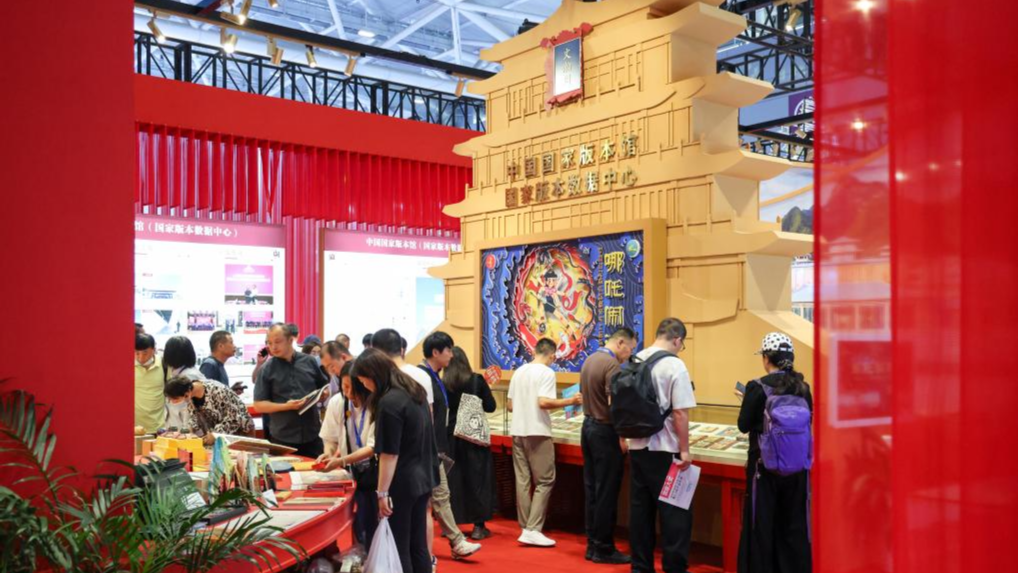
Exhibitors from the Guangdong-Hong Kong-Macao Greater Bay Area (GBA) are pinning high hopes on leveraging China’s largest cultural fair to protect the cultural heritage and enhance the cultural strengths of the southern region.
The 21st China (Shenzhen) International Cultural Industries Fair, which kicked off on Thursday and runs through Monday, features an exhibition hall designated to present the latest cultural developments and innovations in the Greater Bay Area cities, as well as other cities in Guangdong province, attracting hundreds of exhibitors, including internet giant Tencent, robot company UBTECH and autonomous driving firm Pony.ai.
The Greater Bay Area comprises nine Guangdong cities — Guangzhou, Shenzhen, Zhuhai, Foshan, Huizhou, Dongguan, Zhongshan, Jiangmen and Zhaoqing — as well as the Hong Kong and Macao special administrative regions.
READ MORE: GBA will play a significant role in boosting nation’s cultural strength
With a scaffolding-like structure, this year's Hong Kong pavilion highlights the city’s stylish identity. Comprising four major exhibition zones, it features 14 exhibitors, all newcomers to the fair, from various creative fields, including art toys, comics, apparel, and jewelry.
A zone was decorated as a Hong Kong-style cafe, with the sensational art toys Molly, Labubu and Pucky welcoming guests with models of a pineapple bun, a red bean ice drink and Hong Kong-style milk tea.
As the most popular products from Chinese mainland toy company Pop Mart, the three art-toy characters were all designed by Hong Kong artists.
Also enhancing the pavilion’s artistic atmosphere is a giant installation made of hundreds of colorful plastic stools, as well as comic walls and displays of trendy attire and high-end jewelry.
According to William Szeto, curator of the pavilion, this year’s theme was inspired by a casual comment from Kenny Wong, the creator of Molly, who said that “Hong Kong is so stylish!”
Szeto noted that the city is marked by its stylish essence, rich cultural heritage, a free creative ambiance and distinctive narratives. But the significance of these characteristics has been undervalued for some time.
He aims to reintroduce Hong Kong's style to the world through the fair, and said he believes this should also be the mission of the Hong Kong pavilion.
As part of Macao’s highlights at the cultural feast this year, several intangible cultural heritages that are characteristic of the city have been brought to the event. One of them is Azulejo, the art of tile painting brought to Macao from Portugal centuries ago when it was ruled by the European country.
Rachel Lou, a veteran painter who is displaying the technique at the fair, said this form of craftmanship is a unique cultural feature of Macao, but it is at risk of extinction.
“Many people are now interested in cultural products that can have quick economic returns. Traditional techniques like Azulejo, which is purely handmade, require greater efforts for protection and promotion,” she said.
Lou suggested that the government pour more resources into protecting the culture by raising awareness among the younger generation. “Education is important in protecting and promoting the culture. Local schools could arrange for students to visit workshops or take classes so that more young people could get to know the technique and promote its development.”
Shenzhen-based tech giant Tencent is leveraging the cultural event to showcase its artificial intelligence capabilities in energizing content creation and its developments in promoting Chinese culture overseas.
Cai Guangzhong, vice-president of the company, said Chinese culture has seen fast development over the past years, with online dramas, online literature and online games becoming the "new three items" for cultural export.
For example, the first season of Chinese TV drama Joy of Life was broadcast in 27 countries and regions across five continents, while its second season secured partnership with Disney, which distributed the series internationally on its streaming platform Disney+, accelerating its rise to become the most-watched drama from the Chinese mainland.
READ MORE: GBA cultural heritage forum explores new paradigm of interconnection
“We hope to create a ‘Chinese cultural wave’ through the dissemination of ‘new three items’ overseas, with the aim of becoming a leading force in this trend,” Cai said.


